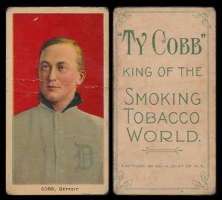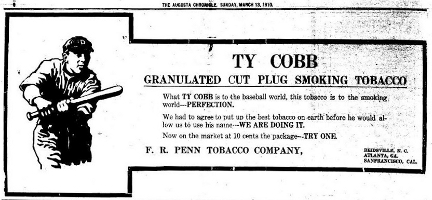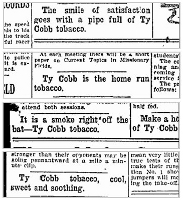"Ty Cobb" King of the Smoking World
by Jim Blumenthal
 March 7, 2012 -- The red-background portrait of Ty Cobb with the "Ty Cobb": King of the Smoking Tobacco World back -- often referred to as the Cobb/Cobb -- is one of the more coveted rarities in our hobby. Catalogued as a T206 in Jefferson Burdick's American Card Catalog, the red Cobb is the only front image for what Burdick considered to be one of 16 tobacco brands advertised on the backs in the white-border set.
March 7, 2012 -- The red-background portrait of Ty Cobb with the "Ty Cobb": King of the Smoking Tobacco World back -- often referred to as the Cobb/Cobb -- is one of the more coveted rarities in our hobby. Catalogued as a T206 in Jefferson Burdick's American Card Catalog, the red Cobb is the only front image for what Burdick considered to be one of 16 tobacco brands advertised on the backs in the white-border set.
All subjects in the T206 set are represented with multiple advertising brands on their backs. Some have significantly more than others. The red-portrait Cobb has the distinction of being the only front that can be found with 15 of the 16 tobacco brands advertised on its back. There are five other "super prints" available with 14 brands.
With only 13 known examples, including one in a museum, the Cobb/Cobb is significantly rarer than the T206 Honus Wagner, often referred to as the holy grail of baseball-card collecting. As knowledge of T206 backs increases -- as well as the popularity of this facet of collecting -- the Cobb/Cobb continues to warrant more attention within the hobby.
The best evidence for dating the Ty Cobb brand is a series of ads that ran four consecutive Sundays in the Augusta Chronicle in 1910, from Feb. 20 to March 13, trumpeting the new Ty Cobb brand of granulated cut plug smoking tobacco. Smaller ads also ran in the Macon Telegraph. These were small, one-line advertisements that began Feb. 8 and appeared in five of the next six days' papers, concluding on Feb. 13.
 |
|
Augusta Chronicle Ad |
Macon Telegraph Ads |
The ads were placed by the F.R. Penn Tobacco Company, at the time a subsidiary of the American Tobacco Company (ATC), which produced T206 cards. ATC took controlling ownership interest of the newly incorporated F.R. Penn in 1904, when ATC purchased two-thirds of the common stock, valued at $150,300. ATC paid $150 a share. F.R. Penn had incorporated itself anew in 1903 in anticipation of its future partnership with ATC. After the stock sale, F.R. Penn ran on the books as a separate company and tried to keep the controlling ownership of ATC a secret in order to avoid a potential antitrust dissolution.
The American Tobacco Company monopoly eventually was broken up in 1911. When the trust was dismantled into several companies in 1911, F.R. Penn was taken over by the new, smaller American Tobacco Company.
The Ty Cobb brand was advertised as a premium tobacco. It is unclear whether it was intended to be a short-lived specialty brand or a long-term product. One can speculate that the popularity of the baseball-card inserts for other ATC-owned brands made the production of a card for the Ty Cobb brand seem logical. If the Cobb/Cobb was distributed with the product during the time the advertisements ran in early 1910, it is unlikely that the red-portrait Cobb was yet available with any other brands of ATC tobacco.
Several months later (perhaps after the quick discontinuation of the Ty Cobb brand) the red-portrait Cobb was included in the 350 print run -- and subsequently in the 460, and "Assorted" print runs.
The Cobb/Cobb has different characteristics when compared with other T206 cards. First, of course, is the fact that only the red-portrait Cobb is combined with this back. All other T206 advertising brands are found with multiple subjects on their fronts. As mentioned, at the time of production for the Ty Cobb brand, the red-portrait card likely had not yet been issued with other ATC brands, so it might have seemed to be a special premium with this particular brand at the time of issue.
The Cobb/Cobb has another unusual quality. While the image of the red-background Cobb is virtually identical to other T206 examples, nearly all of the known Cobb/Cobb cards have a thin, glossy shellac-type layer on their fronts -- something not found on typical T206s.
At least 11 of the known examples have this glossy layer. An example that did not was sold in March 2001 by Robert Edwards Auctions. Slabbed in a PSA "Authentic" holder, the card appeared to have been hand-cut, leading to speculation that it might have been some sort of proof or pre-production example that wasn't placed in tobacco packaging or at the point of sale.
There have been rumors of another example that does not have a glossy front, but that is not confirmed. The glossless, seemingly hand-cut example that PSA authenticated is unquestionably the best known example with regard to condition. The card has bold colors and only minor corner wear. It is in about excellent condition.
There has been debate whether the Cobb/Cobb was correctly cataloged by Burdick as a T206. Some argue that because of the differences when compared to other T206s, the Cobb/Cobb should not be included in the "set". Some collectors have proposed a designation of T206-1, or something similar, for the Cobb/Cobb. A solution that pleases all collectors probably never will be reached.
To some degree, the answer is inherently ambiguous because it hinges on something unknown: Namely, what criteria did Burdick, the person who coined the designation "T206", have in mind when distinguishing cataloged sets in general and T206 in particular. Was the main criteria when, by whom and for what purpose a card was produced? Was it the method of distribution? Was it the physical characteristics of a card? If it was the physical characteristics, which ones? All of them? Some combination?
Because Burdick does not explain his reasoning in the American Card Catalog and it seems he could just have easily and logically cataloged T206s in 16 different sets according to brands -- or three or four sets according to series -- we are left to speculate.
We know that "T206" was the designation Burdick gave to white-bordered cards with baseball subjects that advertised tobacco brands owned by the American Tobacco Company between 1909 and 1911. Because he coined the term and cataloged the cards this way, they are and should be considered to be T206s by definition. Simply put, the person who coins the taxonomy and designates its contents defines it by those designations. But the issue is not that simple.
The glossy front on almost all known examples of Cobb/Cobbs makes it physically different from all other T206s, and some have argued that on those grounds the Cobb/Cobb shouldn't be considered a T206. They speculate that Burdick might never have held an example of the rarity and if he had, he would not have categorized it as he did.
Counter arguments have been made by pointing out that cards with American Beauty backs also have a different characteristic than other T206s in that they are significantly thinner in width. The difference is so noticeable that one doesn't even need to see the back of an American Beauty to recognize the brand.
Another issue that has been raised is the manner of distribution. Some have speculated that the Cobb/Cobb was distributed at the point of sale but not included in the packaging like other T206s. The evidence, however, shows that about half of all known examples of the card have tobacco staining.
For a long time it was thought that the Cobb/Cobb was distributed with the rare and valuable Ty Cobb: Granulated Cut Plug tobacco tins. The corresponding rarity of the tins and cards made this seem reasonable at first glance. Moreover, Lew Lipset, author of the three-volume Encyclopedia of Baseball Cards, attested to a find of a tin and card together in the 1980s.
Supporting the link between the tins and cards is the fact that the tins have a clear designation of "Factory 33," just as the cards do.
But there is skepticism because of a slight difference in name (i.e. the omission of "King of the Smoking Tobacco World") on the tin's packaging. Plus, a recently discovered example of the tin that retains its tax stamp indicates other problems with the presumed link.
The card indicates production at Factory No. 33 in Durham, N.C, whereas the tax stamp on the newly discovered tin indicates production at Factory No. 2? (the full factory number is not legible) in Maryland. Perhaps a more important fact is that the date on the tin's tax stamp is Aug 15, 1912. We know from ads that the brand corresponding with the card was issued in 1910.
An additional issue for consideration on the possible link between the tins and cards is the issue of tobacco staining. About half of the known examples of the card are relatively clean with respect to staining. Those that are stained have it in relatively mild measure. When one compares the relative staining on T206 Polar Bear cards, which were issued with loose-leaf tobacco, with the staining on Ty Cobb brand cards, the typical staining on Polar Bears tends to be significantly stronger and more prevalent.
Nevertheless, the fact that nearly half of the known examples have some tobacco staining leads to the conclusion that they were most likely issued in packaging with the tobacco in some form and not as a point of sale promotion separate from the packaging.
Also worth noting is that although production of the card was short-lived, there is one example of a wet-sheet transfer, indicating at least a couple of sheets were produced that contained the card. Some have speculated that this is not actually a wet-sheet transfer but rather a storage transfer from two cards being pressed against each other for a significant period of time under the right conditions.
There were six examples of the card known in the hobby in 1997, when Rob Lifson of Robert Edward Auctions announced an incredible find of five new examples, which were offered simultaneously in his June 1997 auction.
The five were discovered in Georgia, inside a book (published in 1907) that was owned by the discoverer's great-grandfather. Since that time, two more examples that were newly known to the hobby have been discovered. One is in the collection of former Georgia Sen. Richard B. Russell, who collected tobacco cards as a child in Georgia around 1909-1911. That collection, which includes more than 500 T206s and several hundred T210s, has not only a Cobb/Cobb back but also the even-rarer Doyle "N.Y. Nat'l" card. All are held by and on display at the University of Georgia.
Another example came from outside the hobby and was auctioned by Goodwin and Co. in 2010, bringing the confirmed total to 13.
Because the five examples discovered in 1997 and the Russell example all seem to have originated in Georgia, and the fact that the brand was advertised in the Augusta paper, and because Ty Cobb was a local hero in Georgia, there is speculation that the brand may have been distributed only there.
There remain mysteries and disagreements regarding the Cobb/Cobb. Its status as a T206 probably will remain a topic of enthusiastic debate in the hobby for years to come. What is beyond question is that the card is one of the more noteworthy and desirable cards in the hobby.
(I would like to extend thanks to Tim Cathey and Jim Rivera for technical information and insights on the card and its relation to the production of other T206s. Thank you also to Jon Canfield for information about the Ty Cobb brand tobacco tins.)

